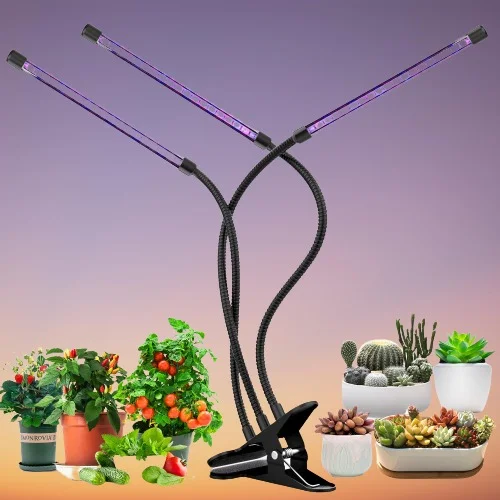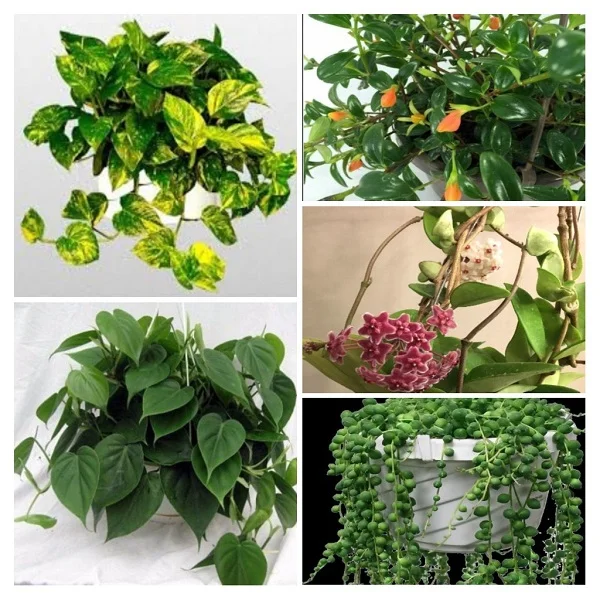Mandevilla Plant Indoor Care, Propagation and Common Problems with Solutions
Some links in this post may be affiliate links
Mandevilla require bright light with some direct sunlight, warm and humid conditions and consistently moist, rich, well-drained soil coupled with fortnightly feeding in the growing season.
Mandevilla are among the evergreen, climbing flowering plants whose stems are densely covered with glossy, dark-green oval leaves and bears brightly colored, large, trumpet-shaped flowers which come in white, pink, yellow, red or mixed colors.
The Mandevilla Plants grown nowadays are hybrids derived mainly from Mandevilla × amabilis, Mandevilla splendens, and Mandevilla sanderi, whereby, the cultivars Mandevilla × amabilis 'Alice du pont' and Sundaville Cream Pink have gained the Royal Horticultural Society's Award of Garden Merit.
Rocktrumpet is perfect for a hanging basket, a pedestal or a trellis where the beautiful leaves and vibrant flowers can be displayed for a spectacular sight.
Mandevilla Plants are tropical plants which require warm and humid conditions to thrive. They are not cold hardy, therefore, they are best grown as indoor plants in the cold temperate climates.
In climates with harsh winters, they can be grown outdoors as container plants during spring and summer which are brought inside when the temperatures drop to about 130C in fall.
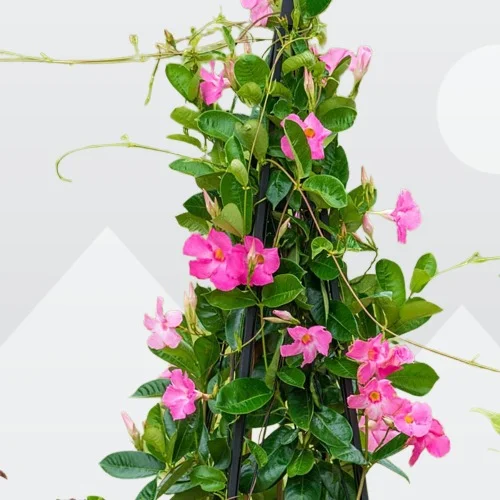
Botanical name: Mandevilla
Family: Apocynaceae
Common names: Mandevilla, Rocktrumpet
Origin
Mandevilla also called Dipladenia is native to the tropical regions of Southwestern United States, Mexico, Central America, the West Indies, and South America. The genus name, 'Mandevilla', is named for Henry Mandeville, a British diplomat and gardener who lived from 1773 to 1861.
Size
Mandevilla Plant is a vining plant which can grow upto 10 feet long when grown indoors making it one of the best flowering plants for hanging baskets.
Flowers
Mandevilla Plant bears fragrant flowers in a variety of colours, which include white, pink, yellow, and red from late spring through fall. On account of its magnificent flowers, Rocktrumpets like Busy Lizzie (Impatiens wallerana) are among the best plants for the main entrance where they will create a great first impression.
Is Mandevilla poisonous?
Yes. Mandevilla are toxic to humans and pets. Keep the plants away from the reach of kids, cats, dogs, and other pets to avoid any mishaps.
Where to Buy
Mandevilla are a spectacular addition to your plant collection. You may obtain these plants online from Amazon (Link to Amazon) or from Etsy (Link to Etsy).
How do you keep Mandevilla alive ndoors?
To keep Mandevilla alive indoors give it bright light with 6-8 hours of direct sunlight, average warmth of 18-300C, humidity of 60-70%, and consistently moist, fertile, well-drained soil coupled with fortnightly feeding during the growing season.
Rocktrumpet care requires regular trimming of the branches to encourage branching as flowers are borne at the tips of new branches. Repotting is only needed when the plant becomes potbound. Keep reading for more details on these growing conditions and how to achieve them.
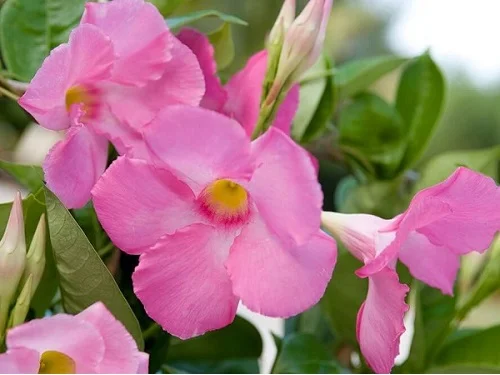
Light Requirements
Do Mandevillas need full sun?
Mandevillas need bright light with 6-8 hours of direct sunlight to promote flowering. A spot infront of a brightly-lit window with some morning or late afternoon sunlight is ideal for these plants.
Too little light will result in leggy growth and lack of blooms. Where the natural light is not adequate, you may instal a full spectrum grow light to supplement it.
Regularly turn the pot to ensure the plant receives adequate light on all sides to promote even growth and prevent the plant from getting leggy.
You can move the plant outdoors for some sun in summer but acclimate gradually to prevent scorching. Ensure to bring it back inside in winter when temperatures begin to drop, it can tolerate up to to 130C.
Watering
How often should I water my Mandevillas?
Water Mandevilla liberally in spring and summer when the top 1-2 inches of soil dry out. Keep the soil consistently moist but not soggy to prevent yellowing and leaf drop.
Decrease watering in fall and winter to maintain the soil slightly moist as growth is minimal at this time. Do not let the soil dry out completely to avoid wilting and leaf drop.
Use room temperature water to avoid shocking the plant as it can cause stunted growth, failure to flower and leaf drop.
Make Sure that the pot has a drainage hole and drain excess water from the catch plate or saucer to prevent the soil from getting soggy as it can lead to root-rot and death of the plant.
Temperature and Humidity
Mandevilla prefers average warmth of 18-300C. Keep it away from cold and hot drafts like windy doors, drafty windows, air conditioning units, hot air vents and others to prevent flactuactions in temperature which may lead to slowed growth and leaf drop.
Rocktrumpet thrives in humidity of 60-70%. Set the pot on a wet pebble tray or use a cool mist humidifier to increase humidity for the plant; low humidity can result in brown leaf tips. Ensure that there is good air circulation to prevent fungal infestations.
Fertilizer
What is the best fertilizer for Mandevilla?
Feed Mandevilla with a phosphorus-rich, water-soluble fertilizer every 2 weeks in spring and summer to boost blooming and healthy plant growth.
Do not feed in fall and winter as growth is reduced at this time and feeding the plant at this time can lead to fertilizer burn and death of the plant.
Potting Soil
The best soil for Mandevilla should be rich in organic matter to provide the required nutrients and at an acidic to neutral PH for optimum growth of the plant. Well-drained soils are recommended for this plant.
Repotting
When to repot Mandevilla?
Repot Mandevilla at the beginning of spring only when it is extremely pot-bound as it blooms best when slightly pot-bound. Do not repot a plant that is in flower as it can shorten the flowering period.
How to repot Mandevilla?
- Select a pot 1 size larger than the current one that has a drainage hole to prevent the soil from getting soggy. Check out these pots with drainage holes on Amazon.
- Fill the pot to a third way full with a well-draining soil and slightly moisten the soil.
- Carefully, slip the plant out of its pot, shake off the old potting mix and trim the dead roots with clean and sterilized scissors.
- Place the plant in the center of the new pot and refill with fresh, free-draining potting mix.
- Thoroughly wet the soil until water comes out through the drainage hole, empty the saucer.
- Replace the plant infront of a brightly-lit window with some 6-8 hours of direct sunlight.
Pruning & Grooming
Pruning Mandevilla involves:
- Removal of dead leaves and flowers to keep the plant neat and minimize pests and diseases.
- Trimming the branches by 1/2 after flowering to encourage blooming as flowers are borne at the tips of new branches.
Regularly clean the leaves with a damp soft cloth to get rid of dust as well as discourage pest infestations.
How do I get more blooms on my Mandevilla?
To get more blooms on your Mandevilla, do the following:
- Give it bright light with 6-8 hours of morning or late afternoon sunlight. Keep it away from hot midday sunshine.
- Keep the soil consistently moist in spring and summer and slightly moist in fall and winter. Never allow the soilball to dry out completely.
- Water with room temperature water to prevent slowed growth.
- Maintain an average warmth of 18-300C and a humidity of 60-70%.
- Pot it in an acidic to neutral PH, well-draining soil that is rich in organic matter.
- Use a pot with a drainage hole to prevent the soil from getting soggy.
- Keep it slightly pot-bound and repot only when extremely root-bound; it blooms best when slightly pot-bound.
- Feed it with a phosphorous-rich, water-soluble fertilizer every 2 weeks in spring and summer but do not feed in fall and winter.
- Regularly remove dead foliage, pinch off the growing tips and cut it back at the beginning of the growing season as flowers are borne at the tips of new branches.

Mandevilla Outdoor Care
Mandevilla are tropical plants which require warm and humid conditions to thrive. They are not cold hardy, therefore, they are best grown as houseplants in the temperate climates.
Nonetheless, in climates with harsh winters, Rocktrumpet can be grown outdoors as container plants during spring and summer which are brought inside when the temperatures drop to about 130C in fall.
Mandevilla Winter Care
- Trim the plant by 1/3 and place it in a warm place where it will receive bright light.
- Reduce watering to keep the soil slightly moist but do not allow it to dry out completely.
- Do not feed it at this time as growth is reduced therefore does not require a lot of nutrients.
- Ensure that the humidity is above average and that there is good air circulation to prevent fungal infestations.
- Once the temperatures warm up to 150C in spring, move the plant outdoors under bright sunlight but shield it from hot direct sunlight to prevent scorching.
- Ensure that the soil remains consistently moist but not soggy by watering when the top 1-2 inches of soil feel dry.
- Feed the plant every 2-3 weeks with a phosphorus-rich fertilizer to boost blooming.
Mandevilla Propagation
Will Mandevilla grow from cuttings?
Yes. Mandevilla is propagated from soft stem cuttings at the beginning of the growing season (spring to early summer) when it is actively growing. You can root the cuttings either in soil or in water.
1. Propagating Mandevilla Plant from soft stem cuttings in soil
- With a sharp, sterilized pruning scissors, take a 4-5 inches of soft stem cuttings from a healthy plant.
- Strip off the lower leaves and dip the lower cut end in rooting powder to hasten rooting.
- Fill a small pot with a well-draining soil and moisten it slightly.
- Insert the lower cut end of the cutting in the moist soil while taking care not to brush off the rooting powder and firm the soil around the base of the cutting.
- Cover the set up with a clear plastic bag or clear polythene to create a greenhouse effect.
- Place the set up in a warm, brightly-lit spot away from direct sunlight to avoid cooking the cuttings.
- Maintain the soil moist through out until the new plant is well established. Rooting occurs in 3-4 weeks.
- Once the new plant is well established, transplant it into a pot one size larger after which you can begin routine care.
2. Propagating Mandevilla Plant from soft stem cuttings in water
- Take 5-6 inches long soft stem cuttings from a healthy plant and ensure it has several leaf nodes as this is where new growth will come from.
- Remove the lower leaves and dip the lower cut end in a rooting hormone to hasten rooting.
- Place the cuttings in a jar of plain water or in a propagation station.
- When the roots are about 3-4 inches long, transfer the cuttings into individual pots in moist, well-draining soil. Rooting will take place in 2-3 weeks.
- Put the pots in a warm, well-lit place away from direct sunlight to prevent scorching.
- Maintain the soil moist until new growth emerges and there is substantial growth.
- Transfer the new plants into a pot 1 size larger than the current one in well-drained soil and begin routine care.
Position the set up in a warm, well-lit spot away from direct sunlight. Change the water every 5-7 days to prevent fungal growth.
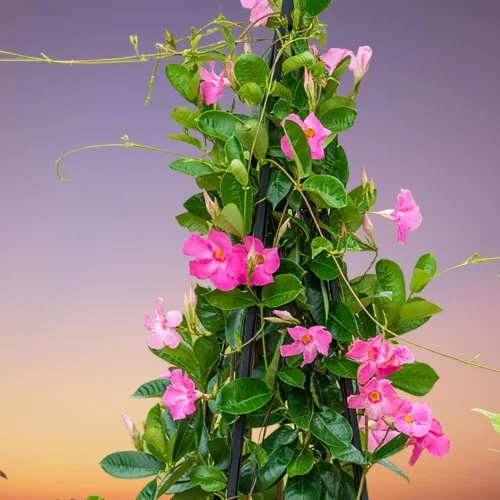
Mandevilla Plant Problems & Solutions
Mandevilla problems are yellowing and falling leaves, leaf drop, curling leaves, flower drop, lack of blooms, plant dying, diseases and pests among others. Keep reading for more on these problems and how to fix them.
Yellowing and falling leaves
What causes Mandevilla leaves to turn yellow and fall off?
Yellowing and falling leaves on Mandevilla is caused by underwatering, overwatering, soggy soil, too little light, nutrients deficiency, and aging.
How to fix it
Underwatering: Maintain the soil consistently moist if spring and summer and slightly moist in fall and winter but never allow the soil ball to dry out completely.
Overwatering: Do not water on a schedule; water only when the top 1-2 inches of soil feel dry to the touch.
Soggy soil: Use a pot that has a drainage hole and free-draining soil. Always empty the saucer after watering and never allow the plant to sit in soggy soil.
Too little light: Move the plant to a brighter place where it will receive bright light with 6-8 hours of morning or late afternoon direct sunlight. Alternatively, grow the plant under a grow light if the natural lighting is too low.
Nutrients deficiency: Feed the plant every 2 weeks in spring and summer with a phosphorous-rich fertilizer.
Aging: As the plant matures, the older leaves turn yellow and fall off; this is a natural process.
Leaf drop
Why is my Mandevilla losing leaves?
Your Mandevilla is losing leaves due inconsistent watering, soggy soil, and temperature stress.
How to fix it
Inconsistent watering: Do not water on a schedule. Water when the top 1-2 inches of soil dry but do not let the soil dry out completely.
Soggy soil: Ensure that pot has a drainage hole and the soil is free-draining to avoid getting soggy soil.
Temperature stress: Keep the plant away from drafts to maintain an average temperature of 18-300C.
Curling leaves
What causes Mandevilla leaves to curl?
Mandevilla leaves are curling due to to dry air, underwatering and extreme temperatures.
How to fix it
Dry air: Set the pot on a wet pebble tray or use a cool mist humidifier to raise humidity.
Underwatering: Water when the top 1-2 inches dry out but never allow the soilball to dry out completely.
Extreme temperatures: Keep the plant away from drafts coming from heat sources, windy doors, AC units among others.
Flower drop
Why are my Mandevilla blooms falling off?
Your Mandevilla blooms are falling off due to underwatering, soggy soil, drafts, and low humidity.
How to fix it
Underwatering: Water when the top 1-2 inches feel dry and never allow the soil to dry out completely.
Soggy soil: Make sure pot has a drainage hole and the soil is well-draining to avoid getting soggy soil.
Drafts: Keep the plant away from drafts originating from AC units, stoves, heat sources, windy doors, drafty windows and other sources.
Low humidity: Use a wet pebble tray or a humidifier, or group the plants together to elevate humidity.
Lack of blooms
Lack of blooms on Mandevilla Plant is due to nutrients deficiency, lack of pruning, and low light.
How do I keep my Mandevilla blooming?
Nutrients deficiency: Fertilize the plant with a phosphorus-rich fertilizer every 2-3 weeks in spring and summer. Avoid high nitrogen plant foods as they promote foliage growth at the expense of blooms.
Lack of pruning: Trim the branches by half after blooming to encourage growth of new branches as flowers are borne at the tips of new branches.
Low light: Position the plant in bright light with 6-8 hours of direct sunshine or use a grow light if the natural lighting is not enough.
Plant dying
What is killing my Mandevilla?
Your Mandevilla is dying due to root-rot which is prevalent in soggy soil. The disease is characterized by yellowing and wilting of the leaves which is rapidly followed by browning and plant collapse.
How do I bring my Mandevilla back to life?
- Slip the plant out of its pot and inspect the roots.
- Trim brown-black mushy roots and treat the healthy roots with a copper-based fungicidal solution as recommended by the manufacturer.
- Disinfect the pot with the fungicidal solution or use a fresh pot to repot the plant in fresh, well-draining soil.
- Do not water the plant immediately and keep it dry for some time before you resume watering.
- To prevent root-rot in the future, use a pot with a drainage hole to prevent the soil from getting soggy.
- Cut down on watering in fall and winter as growth is slowed at this time; maintain the soil slightly moist.
Diseases
Which diseases are common on Mandevilla?
Other common diseases on Mandevilla are:
1. Leaf spot which is enhanced by poor air circulation and presents as brown soft leaf spots.
How to fix it
- Remove and burn the affected parts to reduce the risk of spread to the rest of the plants.
- Spray the affected plant with a systemic fungicide and ensure to follow the manufacturer's recommendations.
- Avoid wetting the leaves during watering to reduce the disease infestation.
- Maintain proper air circulation for the plant to discourage the disease.
2. Powdery Mildew is a fungal disease characterized by spotting or coating of the leaf surface with a white powdery deposit.
How to fix it
- Remove the badly affected leaves and discard or burn to reduce spread to other parts of the plant.
- Spray the plant with a systemic fungicide as per the manufacturer's instructions.
- Improve the air circulation for your plant to reduce occurrence of the disease.
3. Botrytis also called Black Mold is characterized by grey, fluffy mould which can cover all parts of the plant; leaves, stems, buds and flowers.
How to fix it
- Cut all affected parts of the plant and destroy by burning to prevent spread to the entire plant and other plants.
- Remove and replace the moldy soil with fresh well-draining soil and allow the soil to dry out between waterings.
- Spray the plant with a systemic fungicide as indicated by the manufacturer.
- Maintain the soil for the plant on the drier side; reduce watering to keep the soil moderately moist and ensure that the pot has a draiange hole.
- Ensure good air flow for your plant.
Pests
Common pests on Mandevilla are aphids, scale insects, whiteflies and spidermites.
How to fix it
- Seperate the affected plant to prevent spread to the other plants and treat it with neem oil or insecticidal soap as per the manufacturers recommendations.
- Regularly check underneath and between the leaves for these pests and carry out timely control measures.
- Keep the plant well pruned and elevate humidity to discourage the pest infestations.
Frequently Asked Questions
1. Can Mandevilla grow in shade?
No. Mandevilla grows well in bright light with 6-8 hours of direct sunlight. Too little light will result in leggy growth and lack of blooms.
2. How can I make Mandevilla grow faster?
To make Mandevilla grow faster, give it bright light with some sunshine, keep the soil consistently moist, provide average warmth and high humidity, pot it in a pot with a drainage hole and well-draining soil, and fertilize it every 2 weeks in spring and summer.
3. How to make Mandevilla bushy?
You can make Mandevilla bushy by regularly pinching off the growing tips and by cutting back the leggy stems at the beginning of the growing season (spring).
4. How do I encourage my Mandevilla to climb?
To encourage your Mandevilla to climb, give it some form of support like a trellis or a moss pole.
5. Why is my Mandevilla not doing well?
Your Mandevilla is not doing well due to overwatering, underwatering, soggy soil, too little light, temperature stress, dry air, nutrients deficiency, or being extremely pot-bound.
6. Do Mandevillas need to be repotted?
Yes, Mandevillas need to be repotted in spring or early summer when they get extremely pot-bound as they bloom best when slightly pot-bound.
7. Can you put Mandevilla cuttings in water?
Yes. You can root Mandevilla cuttings in water but for stronger plants, transfer the cuttings into well-drained soil once the roots are 2-3 inches long.
You liked it? Share on social media.
Related Content
Amazon Associates Disclosure
Homeplantsguide.com is a participant in the Amazon Services LLC Associates Program, an affiliate advertising program designed to provide a means for sites to earn advertising fees by advertising and linking to amazon.com.



